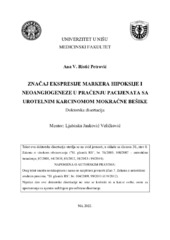Приказ основних података о дисертацији
Značaj ekspresije markera hipoksije i neoangiogeneze u praćenju pacijenata sa urotelnim karcinomom mokraćne bešike
| dc.contributor.advisor | Janković-Veličković, Ljubinka | |
| dc.contributor.other | Jovičić Milentijević, Maja | |
| dc.contributor.other | Radojević-Škodrić, Sanja | |
| dc.creator | Ristić, Ana | |
| dc.date.accessioned | 2023-09-06T14:48:37Z | |
| dc.date.available | 2023-09-06T14:48:37Z | |
| dc.date.issued | 2022 | |
| dc.identifier.uri | http://eteze.ni.ac.rs/application/showtheses?thesesId=8600 | |
| dc.identifier.uri | https://fedorani.ni.ac.rs/fedora/get/o:1887/bdef:Content/download | |
| dc.identifier.uri | https://plus.cobiss.net/cobiss/sr/sr/bib/113307657 | |
| dc.identifier.uri | https://nardus.mpn.gov.rs/handle/123456789/21703 | |
| dc.description.abstract | The most common type of bladder cancer, in over 90% of cases, is urothelial bladder cancer. Seven out of ten cases of urothelial bladder cancer are detected at an early stage. Approximately 70-80% of newly diagnosed present with noninvasive (pTa and pTis stages) or early invasive tumors (pT1 stage). Relapses are frequent and occur in 50-70% of cases, while progression to muscle-invasive (pT2 stage) occurs in 15-25% of cases. In this study, the expression of HIF1α, VEGF, VEGFR1, NOTCH3, JAGGED1, and morphometrically determined density of CD34 positive micro-vessels (MVD) on 613 urothelial bladder cancer samples were immunohistochemically examined. Their interrelationship, as well as, the relationship with clinical-pathological parameters and patient survival were analyzed. The presented study identified HIF1α, VEGFR1, NOTCH3 and MVD as independent prognostic parameters for overall survival and bladder cancer specific patient survival. Positive expression of NOTCH3, higher density of micro-vessels (MVD) and absence of expression of HIF1α and VEGFR1 indicate shorter overall and cancer-specific survival. Molecular participants in HIF1α, VEGF and NOTCH signaling pathways and their detection in tissue show a strong influence of hypoxia and angiogenesis in the formation of more invasive bladder cancer clones. The prognostic value of these markers in the monitoring of bladder cancer patients is great and can contribute to a more individual approach when deciding on further treatment, in order to delay radical cystectomy and preserve the bladder for as long as possible. The latest therapeutic modalities are based on the manipulation of the examined signaling pathways, whose ultimate goal is the introduction of personalized, targeted, molecular therapy in the treatment of urothelial bladder cancer. | en |
| dc.format | application/pdf | |
| dc.language | sr | |
| dc.publisher | Универзитет у Нишу, Медицински факултет | sr |
| dc.rights | openAccess | en |
| dc.rights.uri | https://creativecommons.org/licenses/by-nc-nd/4.0/ | |
| dc.source | Универзитет у Нишу | sr |
| dc.subject | Urotelni karcinom mokraćne bešike | sr |
| dc.subject | Urothelial bladder cancer | en |
| dc.subject | angiogenesis | en |
| dc.subject | hypoxia | en |
| dc.subject | immunohistochemistry | en |
| dc.subject | survival | en |
| dc.subject | prognosis | en |
| dc.subject | angiogeneza | sr |
| dc.subject | hipoksija | sr |
| dc.subject | imunohistohemija | sr |
| dc.subject | preživljavanje | sr |
| dc.subject | prognoza | sr |
| dc.title | Značaj ekspresije markera hipoksije i neoangiogeneze u praćenju pacijenata sa urotelnim karcinomom mokraćne bešike | sr |
| dc.type | doctoralThesis | |
| dc.rights.license | BY-NC-ND | |
| dc.identifier.fulltext | http://nardus.mpn.gov.rs/bitstream/id/151952/Disertacija.pdf | |
| dc.identifier.rcub | https://hdl.handle.net/21.15107/rcub_nardus_21703 |


